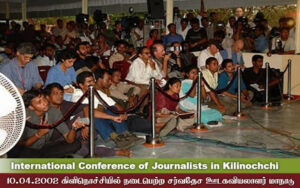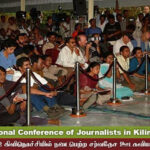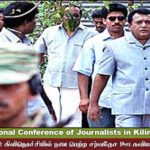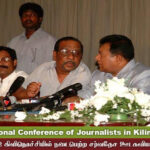

Tamil Eelam’s National Leader International Conference of Journalists in Kilinochchi

Marks the 22nd anniversary of a significant event in Tamil history: the historic press conference convened by Hon. Medagu Ve. Prabhakaran in Tamil Eelam’s homeland. On April 10, 2002, Tamil Eelam’s National Leader addressed over 700 journalists at the International Conference of Journalists in Kilinochchi, engaging in a comprehensive press briefing lasting approximately two and a half hours. During this session, he provided intricate responses to a spectrum of inquiries, particularly concerning peace initiatives. The gathering in Kilinochchi on April 10, 2002, was unprecedented, drawing together Sinhalese media outlets, Indian press, various international media organizations, and representing a landmark moment in Tamil history. Even Sinhalese media characterized the event as unparalleled, surpassing any press conference convened by Sinhalese presidents.
 Two days prior to the scheduled press conference, a significant event unfolded: the opening of the A9 road connecting the North and Sinhalese regions. This moment stands as a watershed in the history of the Tamil freedom struggle. While the national leader, the driving force behind the liberation of Tamil Eelam, had previously engaged with journalists on various occasions, it was only on April 10, 2002, that the LTTE extended a grand invitation to meet its leader, drawing the attention of global media. This marked a departure from the LTTE’s customary practice of conveying policy, program announcements, and messages to the world through the national leader’s speeches on Hero’s Day. For the first time, journalists were afforded the opportunity to directly pose their queries and uncertainties to the national leader, a momentous occasion in their eyes. The ruling Sinhalese party’s reception of this meeting was not without reservation. Sinhalese authorities felt compelled to broadcast the national leader’s media engagement directly on Rupavahini, regarded as the Sinhalese national television network. Their aim was to perpetuate the aura of mystery surrounding the LTTE, thus maintaining its image as a formidable force in the eyes of the world. The Sinhalese leadership never anticipated that such mysteries would be dispelled or that the LTTE’s supreme leader would directly address the world’s questions. However, they were obliged to acquiesce due to the dynamics of unconditional negotiations, ceasefire agreements, and the involvement of third-party mediators. As the leading organization in the armed liberation struggle, the LTTE saw this as an opportunity to articulate their stance amidst evolving global circumstances, conveyed through the authoritative voice of their national leader.
Two days prior to the scheduled press conference, a significant event unfolded: the opening of the A9 road connecting the North and Sinhalese regions. This moment stands as a watershed in the history of the Tamil freedom struggle. While the national leader, the driving force behind the liberation of Tamil Eelam, had previously engaged with journalists on various occasions, it was only on April 10, 2002, that the LTTE extended a grand invitation to meet its leader, drawing the attention of global media. This marked a departure from the LTTE’s customary practice of conveying policy, program announcements, and messages to the world through the national leader’s speeches on Hero’s Day. For the first time, journalists were afforded the opportunity to directly pose their queries and uncertainties to the national leader, a momentous occasion in their eyes. The ruling Sinhalese party’s reception of this meeting was not without reservation. Sinhalese authorities felt compelled to broadcast the national leader’s media engagement directly on Rupavahini, regarded as the Sinhalese national television network. Their aim was to perpetuate the aura of mystery surrounding the LTTE, thus maintaining its image as a formidable force in the eyes of the world. The Sinhalese leadership never anticipated that such mysteries would be dispelled or that the LTTE’s supreme leader would directly address the world’s questions. However, they were obliged to acquiesce due to the dynamics of unconditional negotiations, ceasefire agreements, and the involvement of third-party mediators. As the leading organization in the armed liberation struggle, the LTTE saw this as an opportunity to articulate their stance amidst evolving global circumstances, conveyed through the authoritative voice of their national leader.
 Furthermore, the press conference occurred seven months after the September 11, 2001, Twin Towers attack, which dramatically altered global dynamics and perceptions of armed resistance. Despite the LTTE’s military prowess, which was nearly on par with that of the Sinhalese, the post-9/11 world posed different questions that the national leader was compelled to address.
Furthermore, the press conference occurred seven months after the September 11, 2001, Twin Towers attack, which dramatically altered global dynamics and perceptions of armed resistance. Despite the LTTE’s military prowess, which was nearly on par with that of the Sinhalese, the post-9/11 world posed different questions that the national leader was compelled to address.
Beyond the questions posed and the leader’s responses during the press conference, international media outlets noted with astonishment the leader’s calm demeanor and diplomatic finesse in fielding questions without displaying emotional bias, employing a measured and statesmanlike approach. Sinhalese journalist Ranjan Perera, who attended the conference, remarked, “Prabhakaran’s press conference was an unprecedented event. Despite the challenges, over 300 local and foreign journalists participated. This conference underscored the LTTE’s significance on the global stage. Amidst prevalent speculation, Prabhakaran’s composed demeanor at the conference dispelled misconceptions.”
The responses provided by the leader during this press interaction weren’t merely answers to the questions posed by the media; they transcended to become responses directed at the global audience who watched, listened, and read. These answers, received with keen interest by the world at large, were perceived as remarkable for their clarity and insight.
 The president astutely acknowledged that despite historical evidence suggesting otherwise, Sinhalese chauvinism was unlikely to abandon its oppressive stance. He noted that while the approach to change might be within the Sinhalese domain, the underlying attitude of the Sinhalese leadership remained unchanged.
The president astutely acknowledged that despite historical evidence suggesting otherwise, Sinhalese chauvinism was unlikely to abandon its oppressive stance. He noted that while the approach to change might be within the Sinhalese domain, the underlying attitude of the Sinhalese leadership remained unchanged.
When questioned about the possibility of resuming armed conflict should negotiations fail, the president tactfully responded, “Even in the face of negotiation setbacks, we will persist in our efforts for peace,” indicating a commitment to peaceful resolution. He also dismissed concerns about President Chandrika disrupting talks, expressing confidence that such disruptions would not occur.
Furthermore, by stating, “If such situations arise, it is Ranil’s responsibility to address them,” the president subtly conveyed a message to Ranil, surprising many observers. This echoes sentiments expressed in a similar vein nearly eighteen years prior by Anita Pratap in a March 1984 interview for ‘Sunday’ magazine, highlighting the leader’s perceptions of Sinhalese presidents.
In my opinion, there’s no need for a separate manual or guidebook to understand this leadership. By compiling all the president’s interviews and stirring speeches, one would discern the direction and methodologies this nation should adopt amidst these challenging times. In this period of darkness, they serve as beacons of enlightenment, illuminating the path forward.



